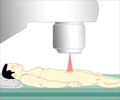Whether to treat men at risk of prostate cancer with the drug finasteride has been the dilemma with doctors for the last six years.
Whether to treat men at risk of prostate cancer with the drug finasteride has been the dilemma with doctors for the last six years. On one hand, the drug had been shown to prevent cancer in about one of every four patients who received it. On the other, those who did develop cancer while on the drug were 25 percent more likely to have a more aggressive form of the disease.
Now new research from Stanford University School of Medicine appears to show that the drug did not cause those more aggressive forms of prostate cancer but simply made them easier to diagnose. The findings, which are to be published July 7 in Clinical Cancer Research, suggest that doctors can be less cautious in use of finasteride.The questions about finasteride treatment can be traced to 2003 when researchers published results from the Prostate Cancer Prevention Trial, a 7-year study that tracked 18,882 healthy men over age 55. That study assigned some of the participants to take finasteride and some to take a placebo. Finasteride, which reduces levels of the male hormone dihydrotestosterone and shrinks the prostate, was found to decrease the prevalence of prostate cancer by about 25 percent. But the drug also seemed to increase the chances that if a cancer was found, it would be fast-growing and likely to spread, again by about 25 percent. As a result, doctors rarely prescribe the drug as a preventive measure.
In reviewing this study, however, a number of researchers, including Stanford's Joseph Presti Jr., MD, noticed that the initial analysis failed to detect a subtlety in the data: The increase in fast-spreading "high-grade" cancers wasn't consistent across all groups and occurred disproportionately in those men who had developed warning signs of the disease.
In men who went through the study without developing any cancer warning signs, finasteride use made no difference in the rate of high-grade cancers diagnosed upon an exit biopsy. But the results were quite different for men who were biopsied after an abnormal digital rectal exam or because of a test showing elevated levels of prostate-specific antigen, a protein also known as PSA that can be unusually high in prostate cancer. Of those men, the ones on finasteride had an 11.5 percent rate of high-grade cancer, compared with 7.7 percent in the placebo group.
That inconsistency suggested something wrong with the initial study analysis, not the drug. Others, including the original study authors, had found evidence that prostate-specific antigen screening works better in men taking finasteride, but no one knew why.
Presti, the Thomas A. Stamey Research Professor in Urology and director of the urologic oncology program at Stanford, and other researchers wondered if it was because of finasteride's propensity to shrink the prostate. A malignant growth in a large, mostly non-cancerous prostate would be easier to miss, they reasoned. If the rest of the prostate tissue was smaller, biopsies would more easily pick up on the cancer tissue left behind.
Advertisement
The team found that the smaller the prostate, the more likely a biopsy would result in a diagnosis of high-grade cancer, and the more likely a high PSA level would predict the disease. In men with prostates between 20 cubic centimeters and 29.9 cubic centimeters, for example, the diagnostic rate for one level of high-grade cancer was 29.7 percent. For men with prostates larger than 80 cubic centimeters, it was just 6.5 percent.
Advertisement
The original cancer trial researchers reached similar conclusions after analyzing their own results, said Catherine Tangen, DrPH, the statistical principle investigator for the Prostate Cancer Prevention Trial and a member at Fred Hutchinson Cancer Research Center in Seattle. Tangen warned that without removing and analyzing the prostates of the men in Presti's study, the true prevalence of undetected prostate cancer remains unknown, leaving the actual sensitivity of the prostate-specific antigen test open to question. But, she said, "Their observations are consistent with everything we found," and suggest that men "should be given the opportunity" to take finasteride if they and their doctors deem it necessary. Prostate cancer affects one in 15 men ages 60 to 69, and one in six men overall will someday get the disease.
Source-Eurekalert
ARU






![Prostate Specific Antigen [PSA] Prostate Specific Antigen [PSA]](https://www.medindia.net/images/common/patientinfo/120_100/prostate-specific-antigen.jpg)






